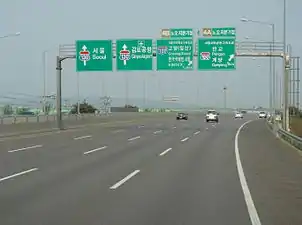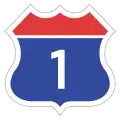


Expressways in South Korea (Korean: 대한민국의 고속도로; Hanja: 大韓民國의 高速道路; RR: Daehanmingukui gosokdoro), officially called as National expressways (Korean: 고속국도; Hanja: 高速國道; RR: Gosokgukdo), are owned by the govermment, and operated mostly by the Korea Expressway Corporation, and to a less extent by the private sector. They were originally numbered in order of construction. Since August 24, 2001, they have been numbered in a scheme somewhat similar to that of the Interstate Highway System in the United States; the icons of the South Korean Expressways are notably similar to those in the United States because they are shaped like U.S. Highway shields and colored like Interstate shields with red, white, and blue, the colors of the flag of South Korea.
- Arterial routes are designated by two-digit numbers, with north–south routes having odd numbers, and east–west routes having even numbers. Primary routes (i.e. major thoroughfares) have 5 or 0 as their last digit, while secondary routes end in other digits.
- Branch routes have three-digit route numbers, where the first two digits match the route number of an arterial route.
- Belt lines have three-digit route numbers where the first digit matches the respective city's postal code.
- Route numbers in the range 70–99 are not used in South Korea; they are reserved for designations in the event of Korean reunification.
- The Gyeongbu Expressway kept its Route 1 designation, as it is South Korea's first and most important expressway.
List of expressways
- red backgrounds are not opened to traffic
Numbering scheme until 2001
A numbering scheme of expressways in South Korea changed in 2001. Before 2001, roads are numbered as order of its approval (although not exactly same). This list below is the lines by the old scheme. Note that name, origin and terminus of some lines are changed with numbering scheme.
| Route number | Route name | Origins (former) |
Terminal (former) |
Approval | ||
|---|---|---|---|---|---|---|
| Former | Current | English | Korean | |||
| 1 | 1 | Gyeongbu | 경부선 | Seoul | Busan | 8 April 1969 |
| 2 | 120 | Gyeongin | 경인선 | Seoul | Incheon | 2 September 1967 |
| 3 | 25, 251 | Honam | 호남선 | Daejeon | Suncheon | 21 April 1970 |
| 3-2 | 253 | Gwangju Bypass | 광주외곽선 | Jangseong | Damyang | 27 August 1997 |
| 4 | 50 | Yeongdong | 영동선 | Yongin | Gangneung | 31 August 1971 |
| 5 | 65 | Donghae | 동해선 | Sokcho | Donghae | 23 August 1973 |
| 6 | 10, 102 | Namhae | 남해선 | Busan | Suncheon | 8 December 1971 |
| 6-2 | 104 | Namhae 2nd Branch | 남해제2지선 | Busan | Gimhae | 22 June 1978 |
| 6-3 | 10 | Masan Bypass | 마산외곽선 | Changwon | Haman | 27 August 1997 |
| 7 | 45, 451 | Guma | 구마선 | Daegu | Masan | 19 March 1976 |
| 8 | 16 | Ulsan | 울산선 | Ulju | Ulsan | 22 June 1978 |
| 9 | 12 | 88 Olympic | 88올림픽선 | Dalseong | Damyang | 22 June 1978 |
| 10 | 35 | Jungbu | 중부선 | Hanam | Cheongwon | 29 May 1985 |
| 10-2 | 37 | 2nd Jungbu | 제2중부선 | Hanam | Icheon | 27 August 1997 |
| 11 | 15, 50, 110 | Seohaean | 서해안선 | Incheon | Muan | 25 July 1991 |
| 12 | 50 | Singal–Ansan | 신갈~안산선 | Yongin | Ansan | 14 July 1988 |
| 13 | 300 | Daejeon Southern Ring | 대전남부순환선 | Daejeon | Daejeon | 14 July 1988 |
| 14 | 55 | Jungang | 중앙선 | Daegu | Chuncheon | 20 October 1989 |
| 15 | 110 | 2nd Gyeongin | 제2경인선 | Anyang | Incheon | 25 July 1991 |
| 16 | 15 | Seoul–Ansan | 서울~안산선 | Seoul | Ansan | 29 April 1992 |
| 17 | 35 | Daejeon–Tongyeong | 대전~통영선 | Daejeon | Tongyeong | 29 April 1992 |
| 18 | 45 | Jungbu Naeryuk | 중부내륙선 | Yeoju | Dalseong | 29 April 1992 |
| 19 | 55 | Busan–Daegu | 부산~대구선 | Busan | Daegu | 29 April 1992 |
| 19-2 | 551 | Branch of Busan–Daegu | 부산~대구선 지선 | Gimhae | Yangsan | 29 April 1992 |
| 20 | 130 | Incheon International Airport | 인천국제공항선 | Goyang | Incheon | 27 September 1993 |
| 21 | 25 | Cheonan–Nonsan | 천안~논산선 | Cheonan | Nonsan | 1 July 1996 |
| 22 | 30 | Daejeon–Dangjin | 대전~당진선 | Daejeon | Dangjin | 1 July 1996 |
| 23 | 30 | Cheongju–Sangju | 청주~상주선 | Cheongwon | Sangju | 1 July 1996 |
| 24 | 40 | Pyeongtaek–Eumseong | 평택~음성선 | Pyeongtaek | Eumseong | 27 August 1997 |
| 25 | 151 | Gongju–Seocheon | 공주~서천선 | Gongju | Seocheon | 27 August 1997 |
| 26 | 20 | Iksan–Jangsu | 익산~장수선 | Iksan | Jangsu | 27 August 1997 |
| 27 | 22,[1] 20 | Gimcheon–Pohang | 김천~포항선 | Gimcheon | Pohang | 27 August 1997 |
| 27-2 | 20 | Branch of Gimcheon–Pohang | 김천~포항선 지선 | Daegu | Yeongcheon | 27 August 1997 |
| 101 | 100 | Seoul Ring | 서울외곽순환선 | Seongnam | Seongnam | 14 January 1988 |
Access restrictions
Motorcycling restrictions


Since June 1, 1972, all motorcycles except police motorcycles are prohibited from driving on expressways in South Korea, regardless of engine displacement. Before 1972, motorcycles with an engine displacement greater than 250 cc were permitted on expressways.[2][3]
Since March 15, 1992, all motorcycles except police motorcycles have been banned from certain other roads designated for motor vehicles only.[4][5][6][7] These roads are marked by a circular blue sign with a white silhouette of a car.
See also
References
- ↑ Abandoned
- ↑ (in Korean) Prohibit the driving on Expressways for Three-wheeled Vehicles and Motorcycles May 23, 1972, Dong-a Ilbo
- ↑ (in Korean) Prohibit the driving on Expressways for Three-wheeled Vehicles etc May 24, 1972, Maeil Business Newspaper
- ↑ (in Korean) Article 58 the South Korea Road Traffic Act(Revised for December 14, 1991, Enforced from to March 15, 1992)
- ↑ (in Korean) Article 63 of the South Korea Road Traffic Act(Revised for May 31, 2005 and April 28, 2006, Enforced from to June 1st 2006)
- ↑ (in Korean) Article 63 of the South Korea Road Traffic Act(Revised for June 8, 2011, Enforced from to December 9, 2011)
- ↑ Law Available in English, requires manual click, South Korea Road Traffic Act












































